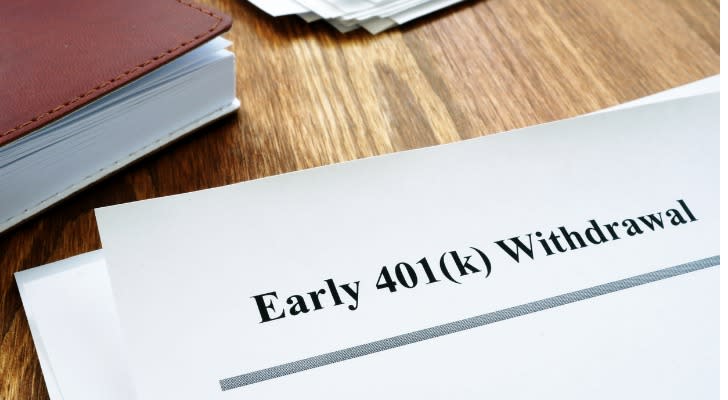
[ad_1]
As you approach retirement age, you may be wondering what to do with the money in your retirement plan. In particular, you want to make sure you’re not losing money due to pesky fees and don’t want your asset allocation to be incorrect for your financial goals in retirement. We’ll break down what you need to keep an eye on, as well as give you some alternatives to taking out your money that can save you from unnecessary taxes and fees.
For more help making the most of your retirement savings plan, consider working with a financial advisor.
Keep an Eye on Fees and Asset Allocations
The first thing to keep in mind when it comes to your retirement plan is fees. Fees can eat away at your retirement savings, and high fees can significantly reduce your investment returns over time. Monitor the fees in your retirement plan and ensure that they are reasonable.
Some fees you may encounter in your retirement plan include:
-
Administrative fees: These are fees charged by the plan sponsor to cover the costs of administering the plan. They can include recordkeeping fees, legal and accounting fees, and other costs.
-
Investment fees: These are fees charged by the investment options in your plan, such as mutual funds or exchange-traded funds (ETFs). They can include expense ratios, sales charges, and other costs.
-
Individual service fees: These are fees charged for specific services, such as taking out a loan or making a hardship withdrawal.
Asset allocation, on the other hand, is the process of dividing your retirement savings among different types of investments, such as stocks, bonds and cash. The goal of asset allocation is to balance risk and reward and help you achieve your retirement goals.
For example, if you invest all your retirement savings in just a few stocks stock, you could lose a significant portion of your savings if those stocks drop in value. However, if you invest in a mix of stocks and bonds, you can reduce your risk by spreading your investments across different asset classes.
Understanding Distribution Options and Tax Implications
When you retire, you’ll need to decide what to do with the money in your retirement plan. You have several options, including:
Leaving Your Money in Your Current Plan
If you’re happy with the investment options and fees in your current plan, leaving your money in your plan may be a good option. You can continue to benefit from tax-deferred growth, and you won’t have to worry about taking required minimum distributions (RMDs) until you turn 73 thanks to the SECURE 2.0 Act.
However, not all plans allow you to leave your money in the plan indefinitely. Some plans may require you to take all your money out at once as a lump sum or require you to start taking distributions at a certain age.
Rolling Over Your Money Into an IRA
Rolling over your money into an IRA can provide you with more investment options to choose from and greater account flexibility. You can also continue to benefit from tax-advantaged growth, and you won’t have to worry about taking RMDs until you turn 73.
However, rolling over your money into an IRA isn’t your only option. Your best decision depends on your financial situation and your plan’s features.
Taking Out Your Money
If you need money to cover expenses in retirement, you may consider taking out your money. However, taking out your money can have tax implications and additional fees (depending on your age). Here’s the details.
-
If you’re under age 59.6, you may be subject to a 10% penalty on top of ordinary income taxes if you take a distribution from your retirement plan (ouch). This penalty is designed to discourage people from taking money out of their retirement plans before retirement.
-
If you’re over age 59.5, you can take distributions from your retirement plan without penalty. However, you will still owe ordinary income taxes on the money you withdraw.
Avoiding Taxes and Penalties
To avoid taxes and penalties, you may consider taking a loan from your retirement plan. Many plans allow you to borrow up to 50% of your account balance, up to a maximum of $50,000. You’ll need to pay back the loan with interest, but the interest payments go back into your retirement account.
Another alternative is to take advantage of partial distributions. Many workplace plans are beginning to allow retirees to take out some of their money as needed and leave the remainder of their assets in the plan. Whether that’s the right decision for you will depend on the rules of your plan, as well as your personal financial situation.
The Importance of a Withdrawal Strategy
In addition to taxes and penalties, taking out your money can also impact your asset allocation. If you withdraw a significant portion of your retirement savings, your asset allocation may become unbalanced. For example, if you take out a large lump sum from your stock investments, you may end up with more bonds and cash than you originally intended.
To avoid this, it’s important to have a plan in place for withdrawing your money in a way that maintains your desired asset allocation. Your financial advisor can help you develop a withdrawal strategy that aligns with your retirement goals and helps you avoid unintended consequences.
The Bottom Line
As you approach retirement age, it’s important to understand your options for your retirement plan. Whether you decide to leave your money in your current plan, roll over your money into an IRA, or take out your money, it’s important to consider the fees, asset allocation, and tax implications of each option.
By monitoring your retirement plan you can make informed decisions that help you achieve your retirement goals and maintain your financial security in your golden years.
Tips on Where to Save for Retirement
-
Finding a financial advisor doesn’t have to be hard. SmartAsset’s free tool matches you with up to three vetted financial advisors who serve your area, and you can interview your advisor matches at no cost to decide which one is right for you. If you’re ready to find an advisor who can help you achieve your financial goals, get started now.
-
A 401(k) takes pre-tax dollars and allows them to grow tax-free. You can only contribute to a 410(k) through an employer and some employers will offer a match. That’s where your employer contributes a certain percentage to your account based on how much you contribute. There is usually a limit to how much your employer will match, but even an extra thousand dollars can really help you. This free 401(k) calculator will show you how money in a 401(k) can grow between now and when you retire.
-
You can also save without going through an employer. That’s where an individual retirement account (IRA) comes in. An IRA offers the same tax benefits as a 401(k) but you can open and maintain an account no matter where you work. It’s important to keep in mind that IRA contribution limits are not as high as 401(k) limits.
Photo credit: ©iStock.com/designer491, DjelicS, Moyo Studio
The post Retirees Are Keeping Their Money Longer in Retirement Plans: Should You? appeared first on SmartAsset Blog.
[ad_2]


